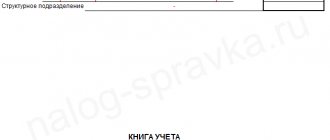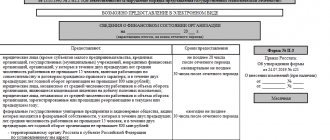What is Form 4 financial statements
Concept and purpose
A sample of the “Cash Flow” form is provided in accordance with Order No. 66n of the Ministry of Finance of the Russian Federation. The form must be filled out according to the results of the current year, it must be submitted in the general package of accounting reports.
What is Form 4 of financial statements, see this video:
Regulatory regulation
Filling out the form in accordance with the standards prescribed in Article 66n allows you not only to submit it on time, but also to avoid mistakes and, accordingly, fines. The main regulatory document that regulates and standardizes the rules for preparing Form 4 of financial statements is Order of the Ministry of Finance of the Russian Federation No. 66n “On Forms of Financial Statements.”
This order is intended to determine the standards for the data that must be present in the report of Form 4. The order of the Ministry is quite often amenable to changes and adjustments, many of the subtleties of the law on accounting forms become more accurate and perfect.
Also, the order of the Ministry of Finance determines the forms of accounting statements that must be submitted by objects and subjects of entrepreneurial activity (including a balance sheet, reports on financial results, capital, intended use of funds and an explanatory note to them). The list of documents and deadlines for submission are also determined by the clauses of the legislative act. The details, codes, and columns that must be displayed on the form are all determined by statute.
Who rents and where?
Form 4 of financial statements must be completed by all legal entities. The exceptions are:
- small and micro enterprises;
- insurance companies, as well as credit organizations;
- budgetary enterprises.
All enterprises that are not on this list are required to regularly submit Form 4 and thereby provide the state with an accurate report on all financial transactions.
Form 4 of the financial statements should be filled out in 2 copies. The first must be signed by the director of the enterprise (this copy is submitted to the Federal Tax Service and the Statistical Service).
It should be remembered that when submitting the form to the federal tax service, you should use the branch in which the company is registered. The document is similarly submitted to the statistical service at the place of registration.
Form 4 must be submitted no later than March 31 of the following year. For example, a report for 2021 must be submitted by March 31, 2021.
Procedure for preparing a cash flow statement
There are two methods of preparing a cash flow statement - direct and indirect. Their difference lies in the parameters of the reflected situation for conducting cash movements. Accountants prepare mandatory cash flow reports using the indirect method, since it is easier to implement and gives a chance to show the differences between operational-type movements and profit data.
Examples of cash flow statements do not show the following indicators:
- Transferring money to internal accounts.
- Exchange rate differences between currencies when there is no subsequent change in the amounts.
- Transformation of funds of another type into financial ones.
- Transfer of funds from the company's account into cash through its own cash desk.
- Barter transactions.
- Offsetting transactions.
- All transactions that are not followed by changes in capital.
When the above transactions caused a change in capital, the report does not indicate the actual cash movement or so-called flow, but the amount difference that the transaction created. Because it is necessary to reflect only situations that create cash flows that lead to changes in funds within capital.
When preparing a cash flow statement, you will have to fill out three basic sections:
- Current account flows (operating activities).
- Flows on investment operations.
- Flows of financial transactions.
Some types of processes that belong to one section in the documentation of the institution under study may belong to a section of a different nature in the documentation for another object. It depends on the underlying activity.
An example for a cash flow statement would be the provision of space for rent. If this type of service is the main type of activity of the company, then the financial movements that arise in these conditions will be classified as operational or current, and if secondary, then to the rank of investment.
Before filling out a cash flow statement, in accordance with the procedure established by law, it is necessary to draw up its title part, which will provide the necessary constituent and legal information about the business entity.
The units of measurement in the document must match those used in the balance sheet - thousands or millions of rubles. All codes used to designate lines must be taken from the fourth appendix to Order 66.
Watch the full video about filling out the DDS report:
How to fill out a report
The accounting regulations, which were drawn up back in 2011, fully describe all the principles and rules according to which Form 4 of the financial statements must be filled out.
- It should be remembered that all negative indicators (the meaning of numbers is negative) that are included in the report must be reflected in parentheses and without the minus sign.
- If indicators must be deducted to recalculate taxes, then the same should be done with them.
The units of measurement used in the Form 1 report are thousands or millions of rubles. Thus, if the indicator is 130 thousand rubles, then you do not need to write 130,000 in the column, you should write just 130, and in the name of the column it should be noted that all numbers are given with the dimension “thousand”. R".
The cash flow statement is described in detail in this video:
Compound
Form 4 of the financial statements contains the following information regarding the movement of finances:
- Current activity;
- investment activities;
- financial activities.
Each variety is divided into the following sections:
- financial flows from current operations;
- financial flows from investment activities;
- financial operations.
Cash flows should be understood as all payments of the enterprise, as well as financial receipts. Receipts of property that has material value (material equivalent) are also taken into account as cash flow.
It should be remembered that there are income that do not significantly affect the total amount of funds. These do not need to be taken into account in Form 4. It is very important for an accountant to be able to separate “important” indicators from “unimportant” ones.
Stitches
In order to describe in detail the principles of filling, we will indicate what should be contained in each specific line.
- Line "4310". Total receipts are displayed here. The value of this line can be obtained by summing 4311-4319.
- Line "4311". The amount of all loans that the company received from banks should be indicated here. The amount is indicated without interest.
- Line "4312" and "4313". Here you should write the contribution that was made by the owner of the enterprise.
- Line "4320". The total payment amount is indicated here. The essence of line 4320 is the sum “4321” - “4329”.
- Line "4321". This displays the total number of all loans that the company managed to repay.
- Line "4322". This displays the amount of dividends that the company paid to the founders of the company.
- Line "4300". This line requires you to indicate the balance of financial flows from operations. Subtracting the line “4320” from “4310”, we get “4300”.
- Line "4400". The balance of the entire financial flow is taken into account here. The content of the line is the sum of “4100”+”4200″+”4300″.
- Line "4450". In this line you must indicate the balance of money at the beginning of the next reporting year. This value must also be written in the explanations to Form 4 of the financial statements.
- Line "4500". The balance of all finance and material equivalents at the end of the year is indicated here. This indicator is easily calculated: “line 4400” + “line 4450” + “line 4490”.
- Line "4490". The difference that arises when recalculating the financial flow and the balance of funds is displayed here. If there are more negative numbers than positive ones, then the contents of the line “4490” should be written in parentheses.
What is the document
The Ministry of Finance established the preparation and submission of this report in 2011 by Order No. 11. He also established PBU “Cash Flow Report” 23/2011.
Later, by Order No. 124 of the same 2011, these norms were slightly changed.
Requirements have been established for the cash flow statement, according to which all financial flows of an enterprise are classified by type of activity and divided into investment type, as well as operational and financial. This division also concerns the frequency of ongoing monetary processes. The purpose of the cash flow statement is to demonstrate these activities in monetary terms.
Form 4 reflects cash and non-cash cash processes. The cash flow report of Form 4 is assigned OKUD code 0710004. Taking into account the parameters of the requirements of legislative documents, to fill it out it is necessary to use the information part for all accounts of the settlement processes of this enterprise, including cash and banking. Consequently, the cash flow statement form also provides indicators for investment processes related to securities.
Filling out form 4
You can download the cash flow statement in Form 4 here.
Form header
Filling out begins with the header of the form. In this case, the sequence of actions is as follows:
- First, a line is filled in where information about the organization is entered. This is the name of the company, its identification code and type of activity (according to the constituent documents).
- Cash flows are then divided into three categories of transactions: current, investing and financing. Each category has two subcategories: receipts and payments.
- Before each type of transaction there are two columns that reflect the amount of money that went through these transactions. Column 3 indicates the amount for the reporting year, and column 4 - for the previous year.
Cash flows from current operations
In receipts, the total amount of receipts is indicated (line 4110). This is followed by a transcript in lines 4111 to 4119:
- sale of goods, works and services;
- financial payments for rent, licenses, royalties;
- assignment of rights to claim monetary payments;
- other supply.
Filling out payment data is carried out in the same way. Line 4120 indicates the total amount of payments, and in lines 4120 to 4129 they are decrypted
- money spent on the purchase of goods, works and services;
- salary fund;
- interest on loan obligations;
- finances spent on paying taxes and other obligatory payments;
- other payments.
Current operations include all operations that cannot be confidently attributed to other sections. Line 4100 of the document indicates the cash flow balance.
Cash flows from investment operations
Investment operations mean investments in scientific projects, as well as equity participation in other enterprises, costs of payments under contract agreements and payments to individual employees in connection with investment activities.
Line 4210 indicates the total amount of receipts. The following is the transcript (lines 4211–4219):
- from the sale of non-current assets, which include real estate and intangible assets, as well as fixed assets. This does not include financial investments in the assets themselves;
- from transactions for the alienation of shares of another enterprise;
- from the return of previously issued loans and from the sale of debt securities;
- from investments in shares and deposits, in other enterprises;
- other supply.
Line 4220 indicates the total amount of payments. In lines 4221–4229 they are deciphered:
- costs for repairs and modernization of equipment and scientific research (including non-current assets);
- purchase of shares and shares of other enterprises;
- purchase of debt securities, borrowing costs;
- payment of interest on obligations in connection with investment activities;
- other payments.
Line 4200 of Form 4 indicates the balance of cash flows from investment operations.
Cash flows from financial transactions
Financial transactions are the attraction of additional capital. It can be represented by loans or borrowings, as well as the sale of equity shares.
Receipts are indicated starting from line 4310 (the total amount of receipts is indicated there). From lines 4311 to 4319 they are decrypted:
- received loan funds;
- increasing participant contributions;
- issue of shares;
- issue of bonds (debt securities).
Payments are indicated from line 4320 (total amount of payments). From lines 4321 to 4329 they are decrypted:
- payments to owners when purchasing shares and interests in case of exit;
- payment of parts of profits;
- payments on loans and credits, on debt obligations.
Line 4300 indicates the balance of cash flows for financial transactions.
Summarizing
Line 4400 indicates the total cash flow balance, which is obtained by adding the balance from lines 4100, 4200 and 4300. If a negative balance is obtained, then the number is written in parentheses. In addition, a few more lines are used:
- In line 4450 the balance is written at the beginning of the reporting period, that is, at the beginning of the year. In line 4500 the balance is written at the end of the reporting period, that is, at the end of the year.
- Line 4490 reflects the impact of changes in the exchange rate of foreign currencies against the ruble. The total amount of differences that arise due to currency conversion at the new rate is shown.
It is important to note that the cash flow statement template does not reflect a complete list of all categories. One operation can belong to several categories. For example, we may be talking about a single payment that relates to different flows. In this case, the amount must be divided among these streams. The flows themselves are reflected in a collapsed form, that is, the indicators do not take into account value added tax.
If the money was received in foreign currency, then the amount must be converted into Russian rubles according to the exchange rate that was valid at the time of the transaction. In addition, the cash equivalents of those assets that do not have a constant price and can be sold at any time without much difficulty must be reflected.
Using Form 4
Usually, financial statements mean information about profits and losses, about the state of the organization at a certain point in time. Reporting documents are prepared and submitted at the end of the reporting period.
Form 4 is used in commercial organizations. The only organizations that do not use it are those that are budget-funded or work in the insurance or lending industries. For these organizations, separate forms of reporting documents and separate accounting rules are used.
Form 4 with the signatures of the head and chief accountant of the organization is submitted to the Federal Tax Service inspection. They are the ones who are responsible to the regulatory authorities for the authenticity and reliability of the information contained in the financial statements.






